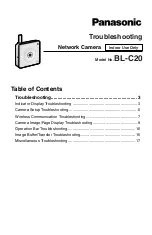
Canopy 400 Series OFDM AP and SM
User Guide
Version 1, April 2008
Page 8 of 40
Figure 3: LOS, nLOS, and NLOS
Whereas multipathing degrades a link in some technologies, like FSK, OFDM can often use multi-
pathing to advantage to overcome nLOS and NLOS, especially in cases where the Fresnel zone
is only partially blocked by buildings, “urban canyons”, or foliage. OFDM tends to help especially
when obstacles are near the middle of the link, and less so when the obstacles are very near the
SM or AP.
However, attenuation through walls and trees is substantial for any use of the 5.4 GHz frequency
band. Even with OFDM, 5.4 GHz products should not be expected to penetrate walls or extensive
trees and foliage.
2.2
APPLICATIONS
Applications for the Canopy 400 Series system include
•
NLOS/nLOS video surveillance in metro areas
•
High throughput enterprise applications
•
Extend networks into urban areas
•
Extend networks into areas with foliage
2.3
CONFIGURATION OPTIONS – RF, IP, DFS
The Canopy 400 Series product uses the Canopy Media Access Controller (MAC) layer. This
means that settings like Downlink Data %, Range, and Control Slots will look very familiar to
operators, and an AP can communicate to over 200 SMs, just as Canopy does.
The GUI (Graphical User Interface) is almost identical to Canopy’s, with a few additions to
support OFDM-specific features.
Canopy network features like High Priority using DiffServ, MIR, CIR, NAT, DHCP and VLAN are
all available for the Canopy 400 Series OFDM radios, and are configured in the same way.
DFS (Dynamic Frequency Selection) is provided for regulatory compliant operation in the 5.4 GHz
band, and is activated using the “Region Code” feature, the same as in Canopy Release 8.2. Two
alternate frequencies can be configured to provide service in the unlikely case a module detects
radar and triggers DFS, the same as standard Canopy. “External Antenna Gain” may need to be
configured consistent with any antennas used, to avoid making the system overly sensitive to








































